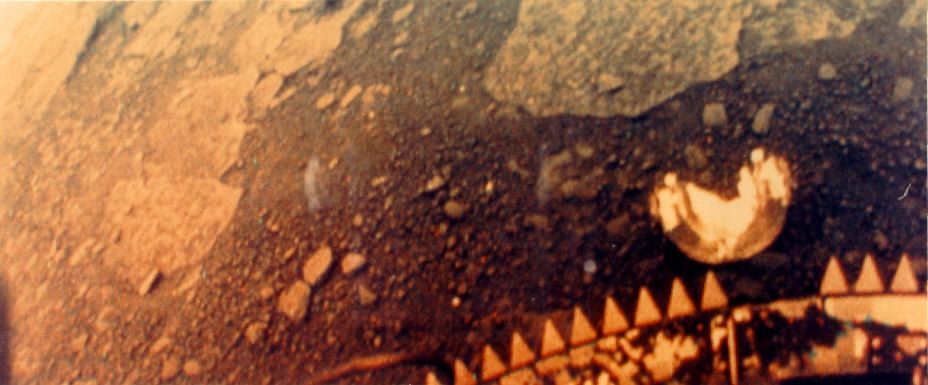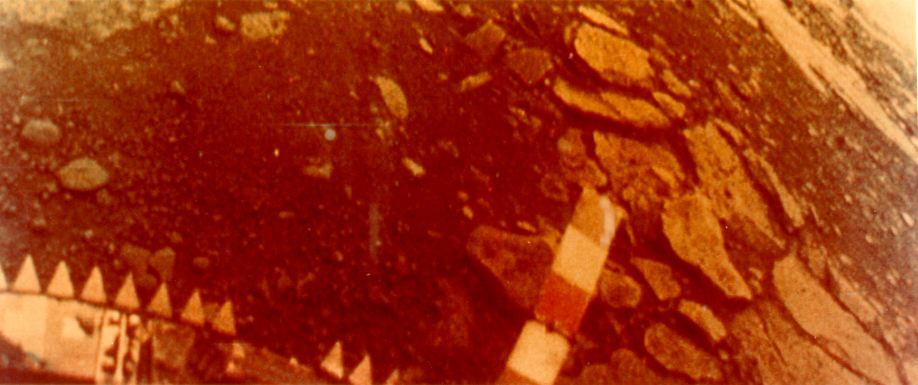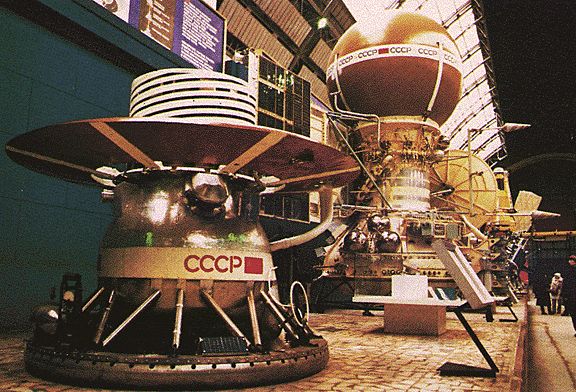Venera 13 and the Mission to Reach Venus
Reference Article

Venera 13, a Soviet spacecraft, was the first lander to transmit color images from the surface of Venus. Although other landers arrived before and after it, pictures from Venera 13 are more widely circulated because they are in color.
The spacecraft was designed to last about half an hour on Venus' harsh surface, but it ended up transmitting data for more than 2 hours after its landing on March 1, 1982. No lander has ventured to the surface of Venus since the 1980s, although several orbiters have made the journey.
Shrouded in secrecy
Documentation on the Venera program is sparse because it took place in the former Soviet Union. More formally known as the Union of Soviet Socialist Republics at the time, the country was the predecessor of today's Russia and surrounding nations. The union dissolved into independent states in 1991.
Unlike the United States' public space program, the Soviet Union preferred to keep all information about its spaceflights private until officials deemed it appropriate to release the news. The Western world was shocked when the Soviets launched Sputnik, the world's first artificial satellite, on Oct. 4, 1957. At the time, few Americans realized that the Soviets had the technology to send satellites into space. Sputnik's launch initiated a "space race" between the U.S. and the Soviet Union that took place under the backdrop of the Cold War.
The Soviets also kept plans for other achievements private until they were accomplished. Some prominent examples include the flight of the first man in space, Yuri Gagarin, on April 12, 1961, and the first spacewalk by Alexei Leonov on March 18, 1965.
Over time, American astronauts and Soviet cosmonauts became friends and shared information. The two nations also had a symbolic mission together in space in July 1975 called the Apollo-Soyuz Test Project.
In the post-Soviet era, Russia became a partner of the International Space Station (ISS) and supplied several of its modules, in addition to cargo services and Soyuz spacecraft for both American and Russian spaceflyers. Russian information about the ISS is now regularly shared with international partners, including the United States.

Early Venus exploration
The primary goal of the Venera program was to learn more about the planet Venus. Astronomers once saw the planet as Earth's twin, and some science fiction writers fantasized about advanced life living below Venus' clouds. [The 10 Weirdest Facts About Venus]
Today, we understand that the planet is a hothouse of pressure-filled atmosphere, capable of crushing an unshielded probe very quickly. Temperatures on Venus can get as high as 870 degrees Fahrenheit (465 degrees Celsius).
Both NASA and the Soviet Union reached for Venus in the early days of their space program in the 1960s, but were hampered by a series of failed probes.
After the failure of Mariner 1, NASA's Mariner 2 became the first spacecraft to fly by Venus on Dec. 14, 1962, revealing a hot planet under high pressure, with unbroken clouds shrouding the surface.
The Soviets had their first successful Venus mission in 1967 – with Venera 4 – after several failed attempts to reach the planet. On Oct. 18, 1967, Venera 4 became the first probe to transmit information back to Earth while entering the atmosphere of Venus.
From there, the Soviets experienced more success. On Dec. 15, 1970, Venera 7 was the first spacecraft to make a soft landing on Venus. The spacecraft transmitted information for 23 minutes on the surface before succumbing to the heat and pressure. Five years later, Venera 9 was the first to send back pictures from the surface.

Venera 13
Venera 13 launched on Oct. 30, 1981, aboard a Proton rocket from the Baikonur Cosmodrome (located in today's Kazakhstan). The spacecraft carried several instruments on board, including spectrometers, a drill and surface sampler, and a panoramic camera.
After a four-month journey to Venus, the spacecraft descended through the planet's atmosphere, plunging through the clouds toward the surface. Venera 13 then popped a parachute and rode it all the way down.
Venera 13 touched down safely on March 1, 1982, in the southern hemisphere of Venus, on an area that the Lunar and Planetary Institute describes as "a typical expanse of Venusian plains." The broad area around the landing site is known to contain lava flows and small dome volcanoes, which may indicate an active surface.
"The [Venera 13] landing site appears smooth but broken, and topped around the lander itself by abundant debris of various sizes," according to an article in Science News published March 20, 1982. "U.S. researchers looking at the photos suggested that the smooth areas might be either solid slabs of rock, or a crust of fine particles cemented together by chemical activity of the atmosphere. Such 'fines' could be dust transported by the wind, or perhaps weathered from the underlying bedrock itself by chemical erosion."

A brief but impactful visit to Venus
For its 2 hours working on the surface, Venera 13 did a lot of science, if one were to judge by the standards of the time. It snapped a panorama of images with its camera, sending back 14 color photographs and another eight in black and white.
The color images from the spacecraft are widely used today in books, magazine articles and websites about Venus. The pictures only show a tiny bit of the sky in the corners, and focus on the surface in front. The spacecraft is visible at the bottom, along with a discarded lens cover.
In some versions, the surface looks yellow, but scientists say it is difficult to figure out what the "true color" of Venus' surface is because the clouds filter out blue light.
Venera 13 also extended a drilling arm to the surface, picked up a bit of Venusian regolith, or soil, and analyzed it inside a sealed chamber. The spacecraft kept track of parameters such as the depth the drill reached and the speed of the drilling rig, to get more information about the surface's physical characteristics
"The results showed that the surface characteristics correspond to compacted ash material such as volcanic tuff [rock]," NASA wrote.
After 127 minutes on the surface, Venera 13 succumbed to Venus' harsh environment.
The Soviet Union sent three more Venera spacecraft to Venus. Venera 14, a twin of Venera 13, launched five days later and also reached the surface. It lasted there for 57 minutes. Venera 15 and Venera 16 subsequently orbited Venus together and sent back information between 1983 and 1984.
Landing on Venus again
Other spacecraft have visited Venus since the Venera series, but all of them were orbiters or flyby missions. The Soviet Union's Vega 1 and Vega 2 both flew by in the 1980s. NASA sent the Magellan spacecraft in 1989, which produced the first high-resolution global map of the surface. The European Space Agency's Venus Express orbited the planet between 2006 and 2014, until it ran low on fuel and was deliberately thrown into the atmosphere.
As of early 2019, Japan's Akatsuki mission is still studying Venus' climate and atmosphere. And, NASA and Roscosmos, the Russian space agency, are discussing a successor Venus landing mission called Venera-D that could last for months on the planet's surface.
Additional resources:
- Read more about each of the 16 Venera missions, according to NASA.
- Learn about other NASA, ESA and Soviet missions to Venus.
- Check out these impressive photos of Venus.
Join our Space Forums to keep talking space on the latest missions, night sky and more! And if you have a news tip, correction or comment, let us know at: community@space.com.
Get the Space.com Newsletter
Breaking space news, the latest updates on rocket launches, skywatching events and more!

Elizabeth Howell (she/her), Ph.D., was a staff writer in the spaceflight channel between 2022 and 2024 specializing in Canadian space news. She was contributing writer for Space.com for 10 years from 2012 to 2024. Elizabeth's reporting includes multiple exclusives with the White House, leading world coverage about a lost-and-found space tomato on the International Space Station, witnessing five human spaceflight launches on two continents, flying parabolic, working inside a spacesuit, and participating in a simulated Mars mission. Her latest book, "Why Am I Taller?" (ECW Press, 2022) is co-written with astronaut Dave Williams.










